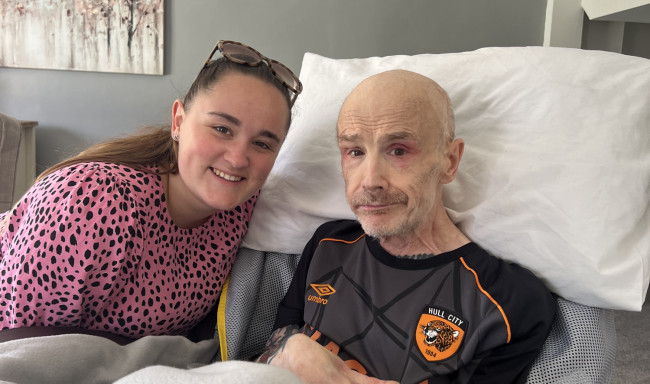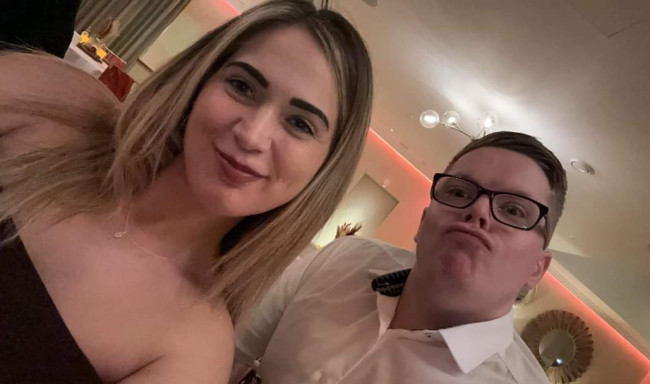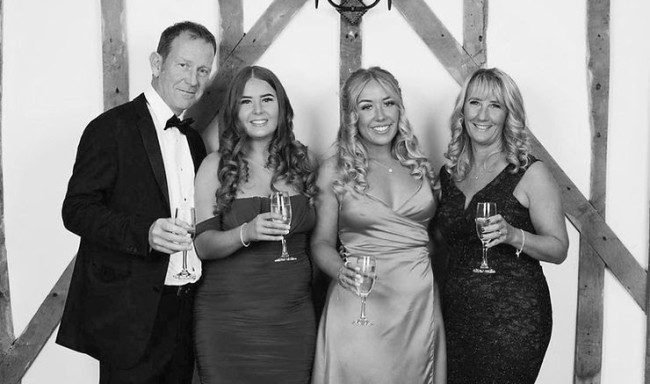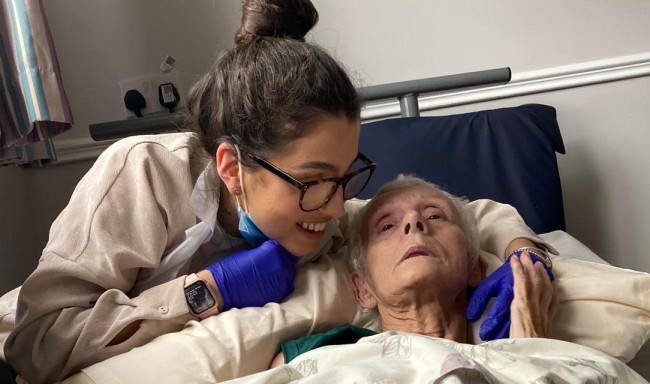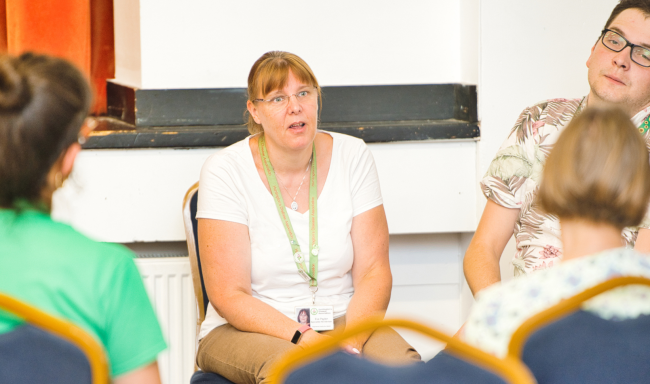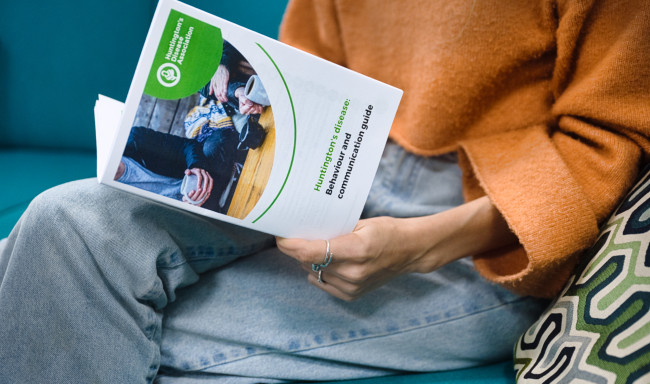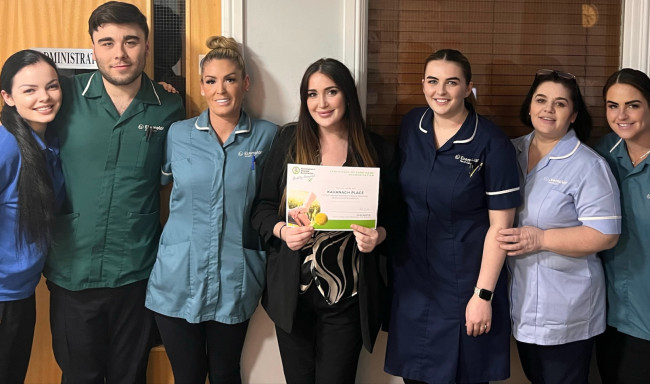Charles Sabine OBE, a former war-zone correspondent for the NBC, recently shared his story at a UK-DRI meeting.
This is a guest blog by University College London researcher, Emma Bunting. Emma caught up with Charles after his talk to discuss his advocacy work, the power of researcher-patient collaboration, his personal experiences with Huntington’s disease, and the ongoing journey towards developing disease-modifying treatments. This feature piece delves into Charles’ remarkable story, exploring these topics throughout.
A courageous shift
Charles’ life-changing journey began in 1994, when his father was diagnosed with Huntington's disease. At this time, the disease was barely on the radar for medical companies, and there was little hope for effective treatments. During his talk, Charles recalled the lack of standards of care during his father’s illness, recounting how people with Huntington's were confined to padded cells and fed through hatches. The emotional burden weighed heavily on families, with the associated stigma causing shame, suffering, misdiagnosis, and misunderstanding. For Charles, this was all compounded by the knowledge that he and his siblings had a 50% chance of inheriting the same fate.
In 2006, he discovered that he too carried the Huntington's gene, with a neurologist delivering the disheartening message that there was nothing he or anyone else could do. He was advised to simply live his life as well as possible. Charles firmly rejected this outlook, thrusting himself into what he describes as a far more challenging battlefield than the war-zones he’d encountered during his NBC career. He had decided to fight against the prejudice and stigma surrounding Huntington's disease.
“I thought, I’m going to do the opposite of what my father did, which was totally hide this disease - even from his own family – for virtually his whole life. And what he did was not unique by any means”.
Charles told me he was able to draw inspiration from the remarkable events he had witnessed throughout his career, seeing them as puzzle pieces that now fit together coherently, giving his life a deeper meaning. Rather than retiring and succumbing to the weight of his diagnosis, he channelled his experiences into a passionate mission of advocacy work.
Unveiling the invisible
During his talk, Charles emphasised the invisibility of Huntington's disease in society and the medical world, a disease too horrifying and complex for many to acknowledge. But he believes that engaging with the disease, not hiding from it, is crucial for coping and making a difference. His advocacy work aims to break the cycle of shame and secrecy, encouraging individuals to face the disease proactively and seek support and information. By unmasking Huntington's, Charles seeks to empower both patients and researchers, fostering a sense of trust, collaboration, and hope.
He came up with a powerful catchphrase, “HiDden No More” which became the slogan for advocacy events that he organised both in the UK and abroad, and is now the name of his foundation. He spoke of the ambitious goal he and his colleagues had, which was to arrange a meeting between Pope Francis and a Huntington's child from Venezuela (where the Huntington's disease gene was discovered). Their intention was for the Pope to hold a “Hidden No More” banner alongside the child, similar to what Charles had done at Downing Street. They realised this would be the first time a world leader had ever spoken the words "Huntington's disease" on record, let alone stood on a world-stage with someone affected by the disease. Charles and his team accomplished something even more extraordinary than they had initially planned. The Pope not only met and blessed 300 people with Huntington's disease but also delivered a powerful message on global television. In three languages, the Pope proclaimed that it was time for the world to acknowledge that Huntington's disease must no longer be hidden, emphasising that this was not just a slogan but a moral course that mankind should follow. Charles said that of all the advocacy work he’s done, this was his proudest moment. He later narrated a documentary about this remarkable event "Dancing at the Vatican," which serves as a testament to the progress made in bringing Huntington's disease into the spotlight and as a platform to further amplify the voice of the Huntington's community.
The power of collaboration
During his talk, Charles emphasised the transformative role of patient groups, which have evolved from sources of emotional support to vital tools for research engagement. He highlighted that this engagement helps to instil hope by showcasing the growing number of individuals and pharmaceutical companies dedicated to developing Huntington's disease treatments. He also pointed out the value that integration between patient and research communities adds for the scientists.
“By connecting with patients and their families, I would imagine that researchers gain an understanding of their daily challenges, fostering motivation and a sense of purpose.”
He firmly believes that collaboration between researchers and the Huntington's community, combined with the continued increased pharmaceutical involvement, will ultimately tackle the disease and the fear surrounding it.
“No generation in the future will have to fear this disease as much as mine has. I have no doubt about it. Completely convinced.”
I couldn’t agree more. In fact, researcher-patient collaboration is so important, that I've written another piece for the UK DRI focusing entirely on this topic.
Trials, setbacks, and hope
Charles shared his personal involvement in the Tominersen trial, a drug that had initially shown groundbreaking results in earlier study phases, lowering the expression of the disease-causing protein (Huntingtin, or “HTT”) in patients for the first time. However, the optimism surrounding this data was soon overshadowed by setbacks during the phase III trial by Roche, when some participants experienced worsened symptoms leading to the trial being prematurely halted.
“The timing of this numbing news was particularly difficult”
Charles recounted, referring to the height of pandemic and lockdown measures enforced at the time.
“People couldn't gather, console each other, or seek support in person. Everyone had to deal with the disappointment and impact of the trial on their own, making the situation infinitely more difficult.”
Adding to the unfortunate timing, another trial by WAVE employing a similar approach announced, almost simultaneously, that their drug had been unsuccessful in lowering the mutant HTT protein. The convergence of these events magnified the collective disappointment and frustration felt by the Huntington's community and researchers alike. Nonetheless, Charles remains optimistic.
“I still regard that whole trial as fundamentally a success, in the sense that it did show some individuals [may have] improved”.
Here, he’s referring to the finding that a subset of individuals on a 16-week dosing regimen showed promising, albeit statistically insignificant, improvements. Roche has since announced they will be carrying out another trial (Generation-HD2) for the same drug, this time focused on younger participants with a lower disease burden who will be treated with less frequent dosing.
Charles also emphasised that the field of Huntington's disease research extends far beyond HTT lowering, making it one of the most exciting areas in medical research today. The number of companies engaged in Huntington's research at the annual CHDI (Cure Huntington’s Disease Initiative) conference has expanded from one to 35 in just 17 years, speaking volumes about the progress achieved so far.
When I asked where he would like to see the field in ten years’ time, he gave a very well-considered response.
“I would like to see a disease-modifying drug available to families. It doesn’t have to be a cure or a blockbuster drug, we just need something that will have even a small effect. Nothing in medicine has ever come along and stopped a disease in its tracks.”
In other words, tackling this disease will not hinge on one monumental triumph – rather, it will be the cumulative effect of many incremental small victories.
A call to action
Charles's journey showcases the triumph of the human spirit in the face of adversity. From the absence of hope and understanding, the Huntington's community has evolved into a force for positive change. Through challenging the stigma, sharing information, and fostering collaboration, the Hidden No More Foundation have laid the groundwork for a promising future. Charles's message resonates strongly, emphasising that every individual possesses the ability to effect change. He urges us to realise that relying on others to improve the world will yield no progress. The time to make a difference is now, and the responsibility lies with us, both patients and researchers alike, to contribute to shaping a new era of medical advances.
You too can soon hear one of Charles’ inspirational talks firsthand, as he is due to give the first ever Ted X Talk about Huntington's disease in Bath on 14 October. If you can’t make it in person, you can watch online. More resources are also available on the Hidden No More website.

